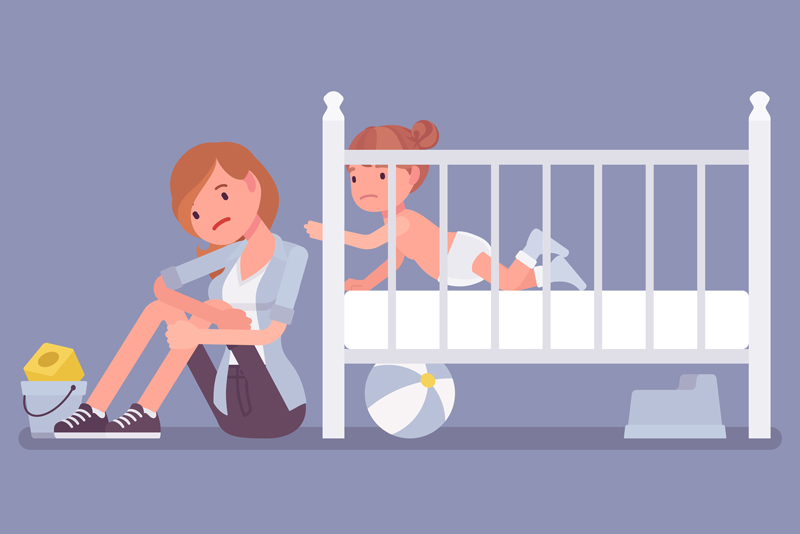Motherhood starts way before a woman discovers that she is pregnant. Rather, research suggests that a person’s projected pathway into motherhood starts as soon as their own infancy. The type of attachment, connection, and personal experiences that a child is exposed to during their first five years of life have been proven to have a significant impact on their future ability to create secure attachment with their own offspring. More specifically, the type of relationship between mother and child has been identified as a significant catalyst for overall well-being and development of future generations. This article explores the intergenerational transmission of maternal trauma to their children.

According to Babcock, Fenerci, and DePrince (2018), intergenerational trauma survivors who become mothers often directly and indirectly transmit their own negative views to their children starting in infancy. John Bowlby, the founder of maternal attachment, discovered that there was a significant link between mother and child attachment, which is directly linked to the emotional and mental well-being of the mother at the time of birth (Iyengar et. al., 2019). A mother’s maternal responsiveness and care to her own child are often a reflection of her own childhood. For example, if a mother was raised by a parent who was often dismissive, unpredictable, and disengaged in daily interactions, these same mothering behaviors are carried into the next generation of child-rearing (Iyengar et. al., 2019; Powers et. al., 2022).
These behavioral patterns and trends are most commonly related to the mother’s model behaviors and inability to establish a secure attachment with their child. Research suggests that the dysfunctional connection between mother and child is linked to post-traumatic stress and inappropriate behavioral responses to “triggers” (Babcock Fenerci & DePrince, 2018; Power et al., 2022). Babcock, Fenerci, and DePrince (2018) studied mothers between the ages of 23 and 47 who experienced significant traumatic events. These traumatic experiences were defined as “childhood maltreatment”: “physical abuse, sexual abuse, emotional abuse, witnessing domestic abuse, or neglect”. The women who participated in this study revealed that their post-traumatic appraisals of themselves were defined by six different categories: “betrayal, self-blame, fear, alienation, anger, and shame”. These post-traumatic feelings and behavioral responses, unless addressed, explored, and replaced, become a survivor mother’s identity. Future generations of children of survivor mothers are often exposed to more negative interactions. These behaviors are described as physical and verbal hostility, avoidant attachment, and less nurturing than those mothers who do not carry unhealed wounds (Iyengar et. al., 2019; Powers et. al., 2022).
When mothers do not address their “ghosts” or explore the “baggage” that they bring from their past, the impact on their child can lead to behavioral and mental health concerns. Children of survivor mothers often view the world as frightening, unpredictable, unfriendly, and unsafe (Powers et. al., 2022).
Mothers who come from generations of the same repeat behavioral trends are unable to recognize that their behavior can be changed due to the modeling of their disorganized memory and attachment (Babcock, Fenerci, and DePrince, 2018). The traumatic experiences impede the brain’s ability to function properly, and the risk for intergenerational trauma continues in a cyclic pattern. There is a disconnection between the ability of survivor mothers to establish parental cognition. The child of the survivor mother often replicates the negative stress responses due to exposure and a lack of secure attachment. A child of a survivor mother often will externalize the internal feelings of the mother through transmission (Iyengar et. al., 2019; Powers et. al., 2022).
The research shows that maladaptive behaviors displayed by survivor mothers stem from their brain’s inability to process these stressful experiences appropriately. Mothers who have experienced trauma are unable to emotionally regulate and find it difficult to connect with their children. This is directly correlated to the mother’s inability to cognitively address their post-traumatic experiences. When a person experiences chronic stress or traumatic experience(s), the brain naturally shuts down the prefrontal cortex and turns on the amygdala (Iyengar et. al., 2019; Powers et. al., 2022). Neurologists discovered that this is a natural stress response, which triggers the brain to go into survival mode. Power et. al. (2022) identified that women who have gone through trauma often have low self-esteem, a lack of awareness, and empathy to face their own internal struggles.
A recent study completed by the National Institute of Mental Health (2023) explored the brain function of infants raised by survivor mothers. The analysis of these brain scans revealed that the brain of an infant shows a mirrored reflection of the mother’s brain, specifically in the amygdala and prefrontal cortex. Therefore, this leads to increased risk for the child of future mental and behavioral health concerns. Research suggests that in order to prevent this type of attachment from being formed, the mother must recognize, treat, and heal from their past traumas. Providing interventions and resources to surviving mothers is critical in order for them to address the triggering event that increases the potential for abuse, neglect, or insecure attachment to take place. Resources should see them through these critical time periods and provide them with appropriate coping mechanisms and modeling of secure attachment in order to put an end to intergenerational trauma (Iyengar et. al., 2019; Powers et. al., 2022). Overall, the teaching of emotional regulation is key in reversing the presence of intergenerational trauma.
Dr. Keiley Pfeiffer, EdD, CAGS in Behavior Analysis, is the Program Manager for Healthy Families Montgomery and Schoharie County at the Integrated Community Alternative Network (ICAN). She is also a Certified Therapeutic Crisis Intervention Trainer. For more information, email kpfeiffer@ican.family or visit ican.family.
References
Fenerci RLB, DePrince AP. Intergenerational Transmission of Trauma: Maternal Trauma-Related Cognitions and Toddler Symptoms. Child Maltreat. 2018 May;23(2):126-136. doi: 10.1177/1077559517737376. Epub 2017 Nov 1. PMID: 29092624.
Iyengar U, Rajhans P, Fonagy P, Strathearn L, Kim S. Unresolved Trauma and Reorganization in Mothers: Attachment and Neuroscience Perspectives. Front Psychol. 2019 Jan 30;10:110. doi: 10.3389/fpsyg.2019.00110. PMID: 30761051; PMCID: PMC6363675.
Powers A, Stevens JS, O’Banion D, Stenson AF, Kaslow N, Jovanovic T, Bradley B. Intergenerational transmission of risk for PTSD symptoms in African American children: The roles of maternal and child emotion dysregulation. Psychol Trauma. 2022 Oct;14(7):1099-1106. doi: 10.1037/tra0000543. Epub 2020 Jan 2. PMID: 31894989; PMCID: PMC7329591.




